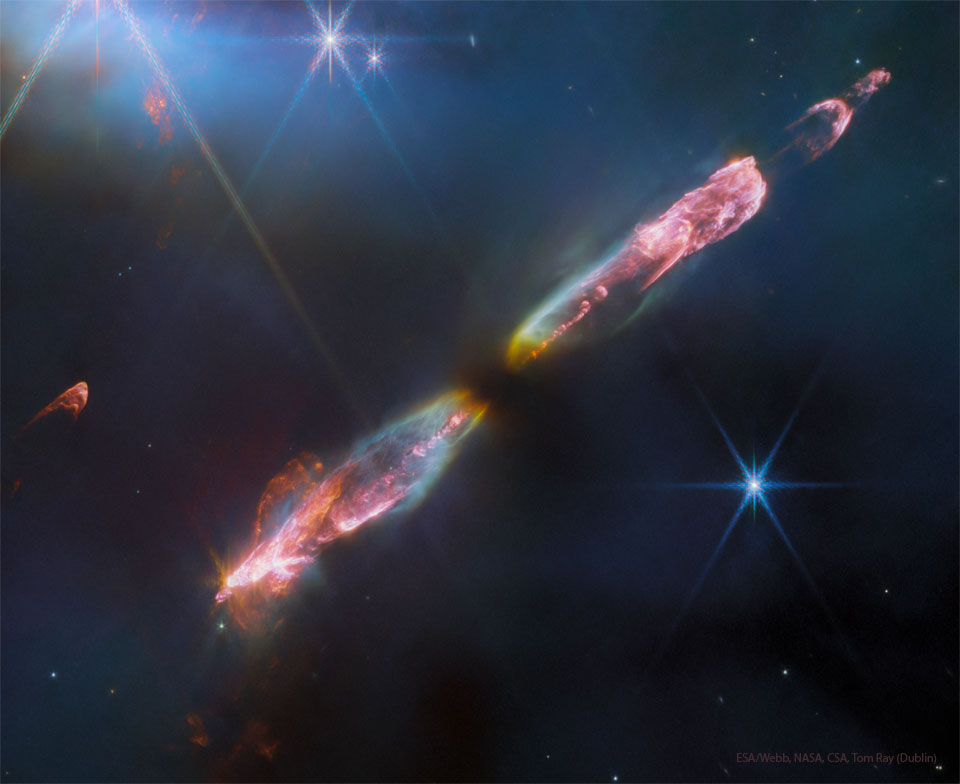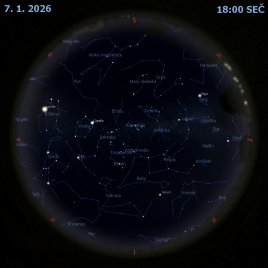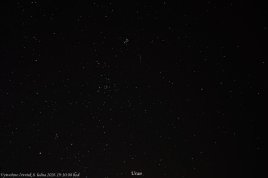HH 211: Výtrysky ze vznikající hvězdy

Uznání: NASA, ESA, CSA, Webb; Processing: Tom Ray (DIAS Dublin)
Vytvářejí vznikající hvězdy vždy výtrysky? Nikdo pořádně neví. Když se oblak plynu gravitačně smršťuje, vytváří disk, který může rotovat příliš rychle na to, aby se dále smršťoval do protohvězdy. Teoretici hypoteticky předpokládají, že tuto rotaci lze snížit vyvrhováním skrze výtrysky. Tato spekulace se shoduje se známými Herbig-Harovými (HH) objekty, mladými hvězdnými objekty, u nichž bylo pozorováno, že emitují výtrysky, někdy velkolepým způsobem. Na obrázku je Herbig-Harův objekt 211, mladá vznikající hvězda nedávno do velkých podrobností zobrazená pomocí Webbova kosmického dalekohledu (JWST) v infračerveném světle. Spolu s dvěma úzkými svazky částic jsou vidět červené rázové vlny, které vznikají při dopadu výtoků na existující mezihvězdný plyn. Jak bude podrobný výzkum vzniku hvězd pokračovat, tak budou výtrysky z HH 221 pravděpodobně měnit svůj tvar a v průběhu příštích 100 000 let se budou zjasňovat a slábnout.
Seznam odkazů v popisu
- NASA: Stars
- Wikipedia: Star_formation#Cloud_collapse
- APOD: 1999-12-19 Akreční disk podvojné soustavy
- Wikipedia: Protostar
- Harvard.edu: A Multi-epoch SMA Study of the HH 211 Protostellar Jet: Jet Motion and Knot Formation
- Wikipedia: Herbig–Haro object
- APOD: 2018-03-11 Duel částicových paprsků v Herbig Haro 24
- WebbTelescope.org: HH 211 (NIRCam Image)
- WebbTelescope.org: NASA's Webb Snaps Supersonic Outflow of Young Star
- Hippopx.com: Foto: Kočka zírá :-)
- WebbTelescope.org: Join Webb on a journey of discovery
- NASA: Infrared Waves
- APOD: 2020-05-25 Ničení tajemného horského strašidla
- APOD: 2020-02-02 Zeta Oph: Prchající hvězda
- APOD: 2010-08-29 Místní chmýří
- HubbleSite.org: UNDERSTANDING THE LIFECYCLES OF STARS
- IAAA.org: HERBIG-HARO (HH) 211
NASA Official: Phillip Newman Specific rights apply. NASA Web Privacy Policy and Important Notices
A service of: ASD at NASA / GSFC & Michigan Tech. U.
Odkaz na originální APOD


